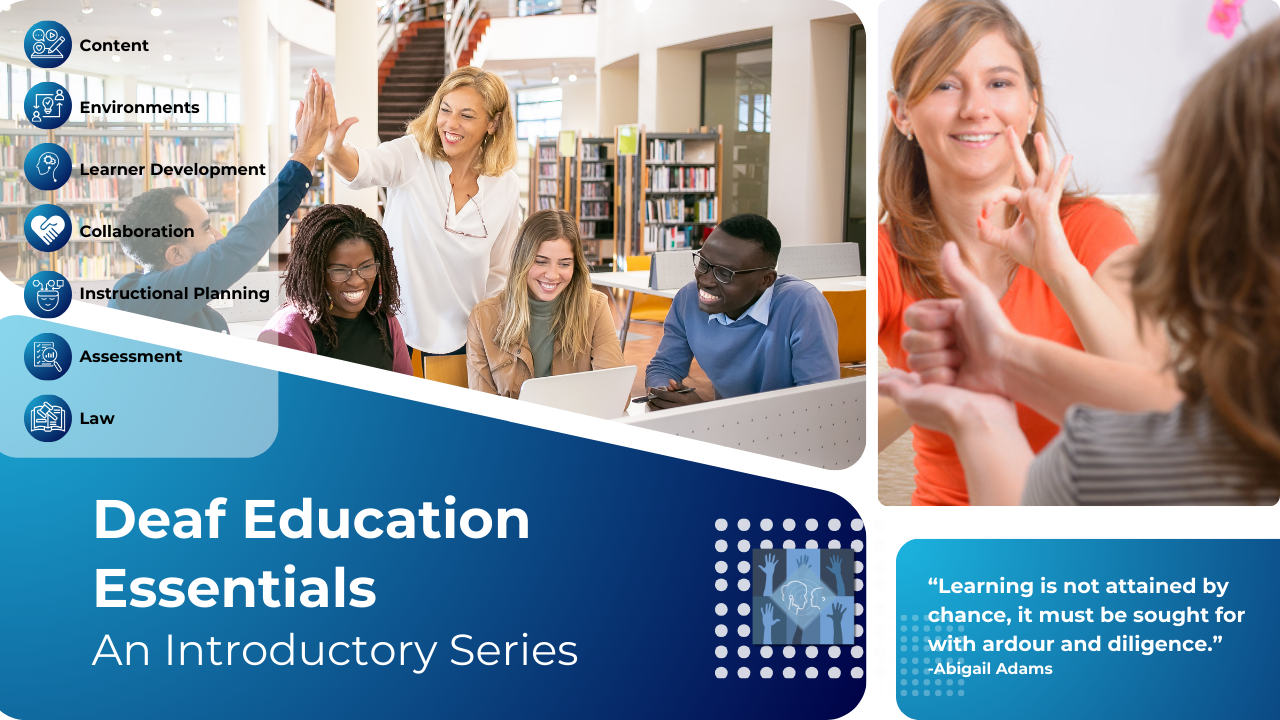Related Products
For Professionals
- Amplification
- Assessment of Student Skills, Challenges, Needs
- Early Childhood: Infants, Toddlers, Preschool
- Hearing Loss – Identification, Impact and Next Steps
- IDEA Law Summary Information
- Language and Speech Development Issues
- Legal Issues in Serving Children with Hearing Loss
- Listening (Auditory Skills) Development
- Planning to Meet Student Needs
- Self-Advocacy Skills for Students with Hearing Loss
- Self-Concept: How the Child with Hearing Loss Sees Himself
- Social Skills
- Speech Perception & Learning
Related Teacher Tools Takeout Items
Supporting Deaf and Hard of Hearing Students in Online Learning Environments: Strategies for Mitigating Visual Fatigue and Split Attention in Times of Teacher Deficits

In their 2023 article, “Online Learning Challenges and Strategies: Visual Fatigue and Split Visual Attention”, published in the American Annals of the Deaf (Vol. 168, Issue 3, pp. 71–92), Pamela Luft and Charlotte Brochu present compelling evidence that online learning environments, as currently structured, often overload the visual channel for DHH students. Their research highlights the impact of visual fatigue and split visual attention—challenges that are rarely addressed when designing virtual instruction
Understanding Visual Fatigue and Split Visual Attention
In tandem, split visual attention refers to the cognitive load that occurs when students must visually divide attention between multiple simultaneous stimuli. For example, a student might need to watch an interpreter in one part of the screen, read captions in another, and observe the teacher demonstrating content or sharing slides—all while trying to take notes or complete tasks. This constant switching can be exhausting and decreases comprehension.
Administrative Considerations During Staffing Shortages
Given the national shortage of TODs and other support staff, many districts are turning to virtual services. While this may be a necessary temporary measure, administrators should not assume that virtual learning is equivalent to in-person instruction for DHH students. Luft and Brochu urge school leaders to acknowledge the specific cognitive and sensory demands placed on these learners and to resist the temptation to “make do” without appropriate supports.
Key takeaways for administrators:
● Avoid overreliance on teletherapy as a substitute for direct services when visual input is required for both communication and instruction.
● Prioritize hiring qualified TODs and seek regional or cooperative service-sharing arrangements when full-time staff cannot be secured.
● Include DHH specialists in planning online learning platforms and curricula to ensure accessibility from the start.
Accommodations and Modifications for Virtual Learning
To reduce the burden of visual fatigue and split attention, educators should implement the following accommodations and modifications:
1. Optimize Visual Layouts
● Use screen sharing thoughtfully: minimize clutter and provide clear focal points.
● Position interpreters and content within close proximity (e.g., picture-in-picture view).
● Allow students to customize layout views (e.g., enlarging the interpreter).
2. Captioning and Transcripts
● Provide real-time captioning for live sessions through trained captioners rather than relying solely on automated captions.
● Make full transcripts of lessons available for review so students can re-process content at their own pace.
3. Scheduled Visual Breaks
● Intentionally build in “visual rest” breaks throughout sessions (e.g., 5-minute breaks every 20-30 minutes).
● Use auditory cues or onscreen timers to indicate transitions, reducing the need for constant visual vigilance.
4. Asynchronous Content with Flexible Access
● Supplement synchronous lessons with pre-recorded videos that students can pause and replay as needed.
● Offer materials in both visual and text-based formats to allow alternate modes of access.
5. Interactive Note-Taking Support
● Provide guided notes or fill-in-the-blank outlines to minimize the need for students to split attention between watching and writing.
● Consider using visual organizers to reduce cognitive overload and help students track information.
Best Practices for Virtual Teachers of DHH Students
● Plan visual flow carefully: Don’t narrate information simultaneously with captioned or signed content—stagger the delivery when possible.
● Check for understanding frequently: Use visual check-ins (e.g., thumbs up/down, reaction buttons, chat box responses).
● Encourage questions: Provide a safe space for DHH students to request clarification without fear of stigma or delay.
● Use consistent sign vocabulary and visual symbols: Consistency reduces cognitive effort.
● Collaborate with TODs and interpreters: Co-plan lessons to anticipate communication barriers and instructional gaps.
Note-Taking Assistive Tech for Virtual Learners
● Otter.ai – Records and transcribes lectures/meetings in real time. Offers speaker identification and keyword summary.
● Microsoft OneNote Dictate – Converts speech into text directly in OneNote.
● Google Docs Voice Typing – Free and easy way to take notes by speaking.
2. Audio Recorders + Smartpens
● Livescribe Smartpen – Records audio while writing and links audio to notes for later review.
● Sonocent Audio Notetaker – Breaks recordings into chunks and lets users highlight, add text, and images alongside.
3. Text Summarization Tools
● TLDR This or SMMRY – Useful for summarizing long articles or readings into digestible notes.
● Scrintal – A visual note-taking tool that helps students connect ideas and summarize readings.
4.Note Organization & Visual Learning Tools
● Notion – Highly customizable note-taking workspace with templates for lecture notes, task tracking, etc.
● MindMeister or Miro – For visual learners who prefer mind maps or flowcharts to organize ideas.
● Obsidian – Uses markdown and backlinks, great for connecting concepts over time (good for building deep understanding).
5. Screen Readers + Highlight-to-Note Tools
● Kurzweil 3000 – Comprehensive reading/writing support for students with learning differences (dyslexia, ADHD).
● Read&Write by Texthelp – Has text-to-speech, highlighting, vocabulary support, and more – perfect for diverse learners.
6. AI Assistants / Auto Notetakers
● Fireflies.ai or Fathom – Automatically records and summarizes Zoom/Meet calls. Helpful for revisiting class discussions or tutoring sessions.
● Tactiq – Captures subtitles from Google Meet/Zoom and turns them into sharable notes with highlights.
Addressing the Growing Shortage of Teachers of the Deaf and Hard of Hearing: A Call for Innovative Credentialing and Service Delivery Models
To address this issue, it is imperative that states, credentialing bodies, and educational institutions collaborate to develop alternative pathways for teacher preparation and certification. These pathways might include grow-your-own models, online credentialing programs, partnerships with school districts, and alternative licensure routes that maintain high standards while removing unnecessary barriers to entry. Without such action, the current trajectory will lead to even greater inequities for students who depend on these specialized services.

Contact Michelle Andros for more information: michelle@success4kidswhl.com
In the meantime, school districts must take immediate steps to optimize the effectiveness of their existing TODHHs. One practical and necessary strategy is to minimize the time these teachers spend traveling between sites by temporarily implementing virtual instruction where appropriate. Virtual services, when used strategically, can extend the reach of TODHHs while preserving the integrity of instruction and maintaining meaningful student engagement. This shift should not replace in-person services long-term but can serve as a stopgap measure to ensure continued support during the teacher shortage.
Ultimately, protecting access to high-quality education for deaf and hard of hearing students requires a twofold approach: investing in sustainable solutions to grow the workforce, and adapting current service models to meet immediate needs. By embracing innovation in both credentialing and delivery, we can help ensure that no student is left without the support they need to thrive.
